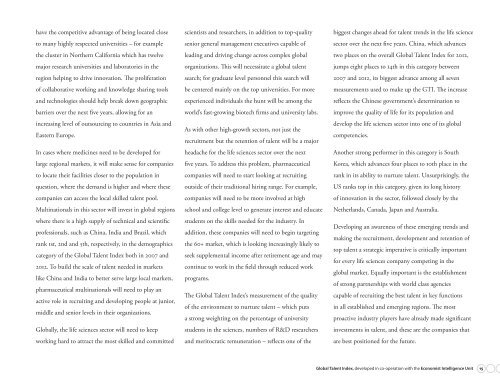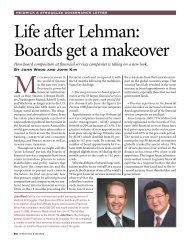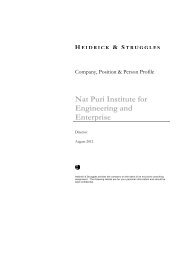Mapping Global Talent: Essays and Insights - Heidrick & Struggles
Mapping Global Talent: Essays and Insights - Heidrick & Struggles
Mapping Global Talent: Essays and Insights - Heidrick & Struggles
You also want an ePaper? Increase the reach of your titles
YUMPU automatically turns print PDFs into web optimized ePapers that Google loves.
have the competitive advantage of being located close<br />
to many highly respected universities – for example<br />
the cluster in Northern California which has twelve<br />
major research universities <strong>and</strong> laboratories in the<br />
region helping to drive innovation. The proliferation<br />
of collaborative working <strong>and</strong> knowledge sharing tools<br />
<strong>and</strong> technologies should help break down geographic<br />
barriers over the next five years, allowing for an<br />
increasing level of outsourcing to countries in Asia <strong>and</strong><br />
Eastern Europe.<br />
In cases where medicines need to be developed for<br />
large regional markets, it will make sense for companies<br />
to locate their facilities closer to the population in<br />
question, where the dem<strong>and</strong> is higher <strong>and</strong> where these<br />
companies can access the local skilled talent pool.<br />
Multinationals in this sector will invest in global regions<br />
where there is a high supply of technical <strong>and</strong> scientific<br />
professionals, such as China, India <strong>and</strong> Brazil, which<br />
rank 1st, 2nd <strong>and</strong> 5th, respectively, in the demographics<br />
category of the <strong>Global</strong> <strong>Talent</strong> Index both in 2007 <strong>and</strong><br />
2012. To build the scale of talent needed in markets<br />
like China <strong>and</strong> India to better serve large local markets,<br />
pharmaceutical multinationals will need to play an<br />
active role in recruiting <strong>and</strong> developing people at junior,<br />
middle <strong>and</strong> senior levels in their organizations.<br />
<strong>Global</strong>ly, the life sciences sector will need to keep<br />
working hard to attract the most skilled <strong>and</strong> committed<br />
scientists <strong>and</strong> researchers, in addition to top-quality<br />
senior general management executives capable of<br />
leading <strong>and</strong> driving change across complex global<br />
organizations. This will necessitate a global talent<br />
search; for graduate level personnel this search will<br />
be centered mainly on the top universities. For more<br />
experienced individuals the hunt will be among the<br />
world’s fast-growing biotech firms <strong>and</strong> university labs.<br />
As with other high-growth sectors, not just the<br />
recruitment but the retention of talent will be a major<br />
headache for the life sciences sector over the next<br />
five years. To address this problem, pharmaceutical<br />
companies will need to start looking at recruiting<br />
outside of their traditional hiring range. For example,<br />
companies will need to be more involved at high<br />
school <strong>and</strong> college level to generate interest <strong>and</strong> educate<br />
students on the skills needed for the industry. In<br />
addition, these companies will need to begin targeting<br />
the 60+ market, which is looking increasingly likely to<br />
seek supplemental income after retirement age <strong>and</strong> may<br />
continue to work in the field through reduced work<br />
programs.<br />
The <strong>Global</strong> <strong>Talent</strong> Index’s measurement of the quality<br />
of the environment to nurture talent – which puts<br />
a strong weighting on the percentage of university<br />
students in the sciences, numbers of R&D researchers<br />
<strong>and</strong> meritocratic remuneration – reflects one of the<br />
biggest changes ahead for talent trends in the life science<br />
sector over the next five years. China, which advances<br />
two places on the overall <strong>Global</strong> <strong>Talent</strong> Index for 2012,<br />
jumps eight places to 14th in this category between<br />
2007 <strong>and</strong> 2012, its biggest advance among all seven<br />
measurements used to make up the GTI. The increase<br />
reflects the Chinese government’s determination to<br />
improve the quality of life for its population <strong>and</strong><br />
develop the life sciences sector into one of its global<br />
competencies.<br />
Another strong performer in this category is South<br />
Korea, which advances four places to 10th place in the<br />
rank in its ability to nurture talent. Unsurprisingly, the<br />
US ranks top in this category, given its long history<br />
of innovation in the sector, followed closely by the<br />
Netherl<strong>and</strong>s, Canada, Japan <strong>and</strong> Australia.<br />
Developing an awareness of these emerging trends <strong>and</strong><br />
making the recruitment, development <strong>and</strong> retention of<br />
top talent a strategic imperative is critically important<br />
for every life sciences company competing in the<br />
global market. Equally important is the establishment<br />
of strong partnerships with world class agencies<br />
capable of recruiting the best talent in key functions<br />
in all established <strong>and</strong> emerging regions. The most<br />
proactive industry players have already made significant<br />
investments in talent, <strong>and</strong> these are the companies that<br />
are best positioned for the future.<br />
<strong>Global</strong> <strong>Talent</strong> Index, developed in co-operation with the Economist Intelligence Unit 1
















